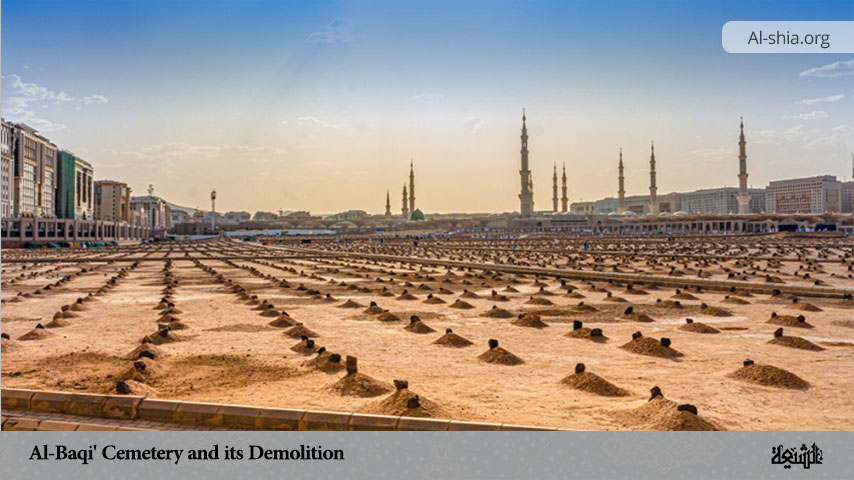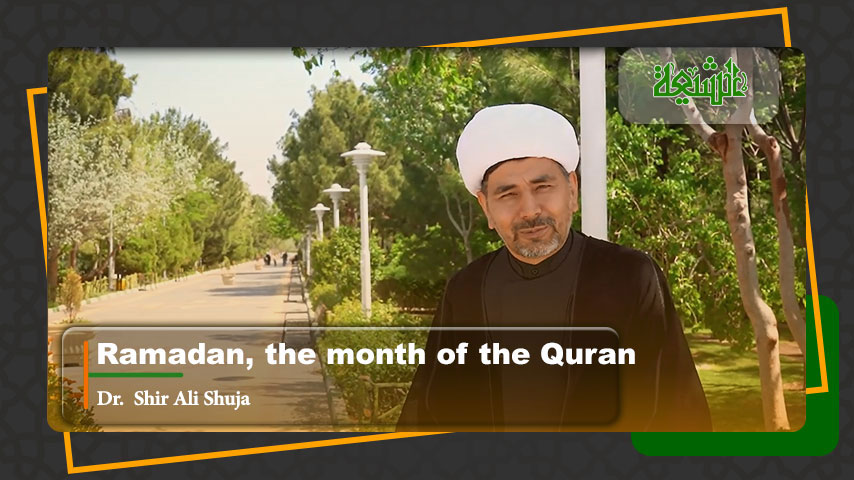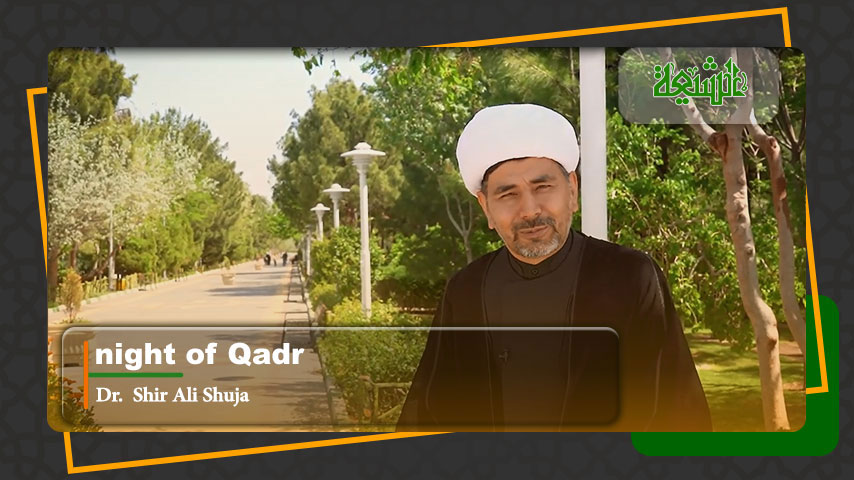Al-Baqi’ also known as Al-Baqi’ cemetery is the first and oldest Islamic cemetery of Madina which is located to the southeast of the Prophet’s Mosque and contains the graves of some of the Prophet Muhammad’s family and his companions. Some hadiths have been narrated from the Holy Prophet (peace be upon him and his household) as well as the Imams (peace be upon them) about the merits of this cemetery.
Al-Baqi’ is used to refer to a piece of land covered by a certain type of thorny plant called Gharqad. According to historical records, when Prophet Muhammad (peace be upon him and his household) arrived at Medina from Mecca in September 622 CE, al-Baqi’ was cleared and consecrated to be the future cemetery of the Muslims who died at Medina. In the past, the cemetery was located outside the city and one of the city gates called Bab al-Baqi’ opened to the cemetery. However, due to the expansion of the city in recent years, al-Baqi’ has been neighboured by the city from the side of al-Masjid al-Nabawi’s courtyard and the mosque and the cemetery are separated by a street.
During the lifetime of the Holy Prophet (peace be upon him and his household), Al-Baqi’ was much smaller in size but during different periods, the size of al-Baqi’ has been changed and its area has been expanded to what we have today.
It is documented that when As’ad ibn Zurarah, who was one of the Prophet’s companions died, the Prophet chose the spot to be a cemetery and As’ad was the first person among the Ansar to be buried in al-Baqi’. Similarly, when the Messenger of Allah (peace be upon him and his household) was outside Medina for the Battle of Badr, his daughter Ruqayyah died in 624. She was buried in al-Baqi’. Thus, she was the first person from the Prophet’s Household to be buried in this cemetery. In addition, after the Prophet’s return from the Battle of Badr, Uthman ibn Maz’oon died in 624/625 CE and was buried in al-Baqi’. He was considered the first companion of Muhammad from the emigrants (Muhajir) to be buried in the cemetery.
It is also documented in reliable historical reports that four of the Shi’a Imams (peace be upon them), that is, Imam al-Hasan, Imam al-Sajjad, Imam al-Baqir, and Imam al-Sadiq (peace be upon them) are buried in this cemetery and possibly the grave of Lady Fatima al-Zahra (peace be upon her) is also believed to be there although its actual spot is unknown. Thus, Al-Baqi’ is considered among the holiest pilgrimage destinations for Muslims, especially the Shiites. Besides, Muslims around the world particularly at the time of hajj, pilgrims of hajj often go to Medina and visited this cemetery and the graves and shrines there.
It is pertinent to mention that domes and shrines were built on the graves of noble ones such as the four Shi’a Imams (peace be upon them) and ‘Abbas ibn ‘Abd al-Muttalib which, was referred to as a grand building by Ibn Jubayr. In the first half of the 8th/14th century, Ibn Battuta described al-Baqi’ thus: “Malik b. Anas’s grave with a small dome and Ibrahim’s grave had a white dome on it. There was a tomb in which wives of the Prophet were buried. The ‘Abbas and the Imams of al-Baqi’s tombs had grand domes upon them. The grave of the third caliph had a big dome upon it and the grave of Fatima bint Asad was near it.”
With the emergence of Wahhabi ideology in Hijaz which was inspired by the ideology of Ibn Taymiyya, they believed that building anything upon graves and visiting them is against monotheism and therefore, in addition to the demolition of the graves in Ta’if, Jedda, Karbala, and elsewhere, Wahhabis focused their efforts on demolition of shrines and domes of religious sites in Mecca and Medina.
In 1220/1805-6, Wahhabis besieged Medina and after the city was surrendered, Sa’ud b. Abd al-‘Aziz seized all the properties in the treasures of the Shrine of the Prophet (peace be upon him and his household) and ordered the demolition of all the domes in al-Baqi’ and all buildings of such form in different regions of Hijaz. on the 8th of Shawwal, Wednesday, in the year 1345 AH (April 21, 1925), mausoleums in al-Baqi’ Cemetery were demolished by King Ibn Saud.
The shrine of the four Imams (peace be upon them) and the dome of Lady Fatima (peace be upon her) known as Bayt al-Ahzan (i.e., the house of sorrows) were either destroyed or seriously damaged in the first attack of Wahhabis in the same year. According to Abd al-Rahman Jabarti, after a year and a half of besieging Medina and causing starvation, Wahhabi forces entered the city and destroyed all the graves and tombs except the shrine of the Messenger of Allah (peace be upon him and his Household).
Contrary to Wahhabi beliefs, the Muslim majority (of both Sunni and Shi’a) are of the view that building mausoleums upon graves is not against Islamic beliefs and in addition, visiting the graves of religious figures and believers is a recommended act that has a long history in Islamic tradition. Besides, the religious sites in al-Baqi’ had historical importance as well and reminded the historical identity of Muslims.
Therefore, the demolition of al-Baqi’ sparked wide protests among Muslim countries and many religious and political leaders of Islamic countries reacted to this extremist behaviour of Wahhabis and condemned it. People of Azerbaijan, Uzbekistan, Turkmenistan, Iran, Turkey, Afghanistan, Iraq, China, Mongolia, and India expressed their sorrow and criticism in many correspondences and consequently, the Islamic government of Iran announced Safar 16, 1344 AH (equivalent to September 5, 1925) the national mourning day on the occasion of desecration of al-Baqi’. Since that time until date, on Shawwal 8 of every year, which is known as Yawm al-Hadm (i.e., Day of Demolition), many Shiites across the world hold gatherings to remember the event and mourn. In other words, Yawm al-Hadm (lit. Day of Demolition) is the anniversary of the day on which al-Baqi’ Cemetery in Medina was demolished.
In Dhul-Hijjah, 1227/1812, the Ottoman Empire sent an army under the commandership of the king’s son, Ibrahim Pasha to quench Wahhabis. They sieged Medina and killed many Wahhabis and arrested many others who had taken refuge in a fort near Bab al-Shami. Saud b. Abdulaziz was defeated and his attempt to convince Muhammad ‘Ali Pasha not to surrender him and his fellows to the Ottoman king was unsuccessful and Medina was taken back. Some monuments and shrines were reconstructed in 1234/1818-9 by the order of Sultan Mahmud al-Thani (ruling from 1223/1808-9 to 1255/1839-40), as some reports suggest the existence of shrines after those years.
In 1344/1926, another invasion of Medina by Wahhabis took place, and all historical monuments of the al-Baqi’ Cemetery were demolished following the religious verdict (i.e., Fatwa) of Shaykh Abd Allah Bulayhad, the chief judge of Saudis claiming that visiting graves is a sign of polytheism and illegitimate innovation.
From that time until date, the graves of the four Shi’a Imams (peace be upon them) and other great Islamic personalities in al-Baqi’ Cemetery have no signs other than little pieces of stones on them. Although in comparison to the time of its demolition, the condition of al-Baqi’ is a little better, but Saudi government refuses to look after this cemetery properly. Muslims, especially Shi’a have not forgotten the event of demolition and now when they go to Medina, despite the restrictions the Saudi government has put for the visitors of al-Baqi’, Shi’a visitors attend in al-Baqi’ and visit demolished graves of the religious personalities buried in this cemetery and express their resentment of the demolition of their graves.
It is pertinent to mention that the destruction of sacred sites in Hijaz by the Saudi government continues even today. According to some scholars what is happening in Hijaz is actually a conspiracy plotted by the Jews against Islam, under the guise of Tawheed. The idea is to eradicate the Islamic legacy and heritage and to systematically remove all its vestiges so that in the days to come, Muslims will have no affiliation with their religious history.
In several verses of the Holy Qur’an (such as Qur’an, 22:32; Qur’an, 40:81; Qur’an, 31:32), the Almighty Allah Who is All-Knowing has referred to the “Signs” of Allah. The “signs” have been places, events, personalities, catastrophes, and many other things, but one thing which can be observed is that according to the Holy Qur’an, the “Signs” (or Ayats) are meant to remind people of Allah, His Bounties, His Mercy, His Wrath, and his other attributes. Therefore, places, symbols, historical events, or personalities, which serve as reminders and symbols for humanity, and strengthen the bonds of love and submission to Allah, are to be respected, revered, and remembered, not only as a rite or ritual but also in their true spirit.
In light of this, in addition to those “Signs” mentioned in the Holy Qur’an, events, places, and personalities, which strengthen man’s ties and attachment to the Almighty Allah, are to be preserved, loved, and respected.
















